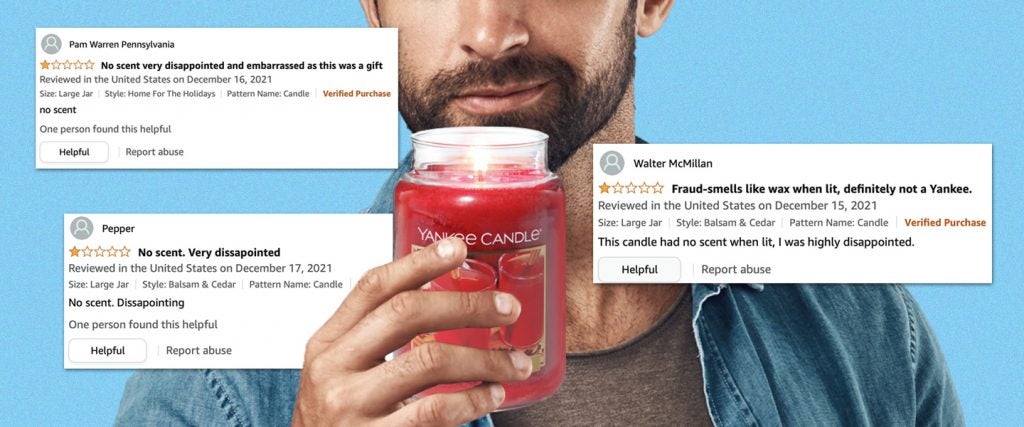I was raised in a region dominated by a singular candle brand: Yankee Candle. Their headquarters are essentially the Disney World of Western Massachusetts. Inside their flagship store in Deerfield is a maze of candle-themed rooms: a Christmas village complete with periodic fake snowfall, a miniature Halloween town, a Wonka-like candy store. But the pièce de résistance is a grocery store-sized room lined with every scent on the Yankee market. Any visit would not be complete until I smelled the entirety of their collection and got a migraine.
But imagine a world in which our beloved Yankee Candles have no scent at all.
According to dozens of Amazon reviews from December 2021, this is a nightmare many of us are already living in. “No scent, very disappointed, as this was a gift,” wrote Pam Warren of Pennsylvania, absolutely humiliated by the olfactory failures of her large-sized “Home for the Holidays” candle.
There may, however, be an explanation: Everyone has COVID. Last week, @drewtoothpaste posted a series of screenshots of bad Yankee Candle reviews he’d found from Amazon to Twitter. In response, political scientist @nick_beauchamp plotted out a chart documenting the frequency of complaints pertaining to scentlessness from the top three Yankee candles on Amazon since January 2020, when the pandemic began. What the chart shows is that both last December and this year, there have been dramatic spikes in supposed scentless candles.
Of course, some of this is simply due to the fact that candle sales (particularly Yankee Candle’s top scents) go way up during the winter. What kind of sick freak lights up a 22-ounce “Balsam and Cedar” in the heat of July? But Beauchamp also made a chart tracking the percentage of reviews complaining of candles having no scent, and the pattern was the same — during the last two winters, it’s not just that more people are reviewing candles, but that a much higher percentage of reviews mention “no smell” than usual.
None of this would be particularly interesting had some savvy users not pointed out that something else coincides with these winter reports and often causes people to lose their sense of smell: that goddamn novel coronavirus. It seems that candle fans are receiving their products just as the earliest symptoms of the illness begin to set in, firing off their angry reviews before they even know they’re sick.
If you look back a bit further in the data, before COVID-19 was a pandemic, it does appear that these Yankee Candle reports happen every year during the winter when more people get sick –– after all, even the common cold can cause you to briefly lose your sense of smell. That said, rates are indeed higher than usual during our last two COVID winters.
So what does any of this mean? Are Yankee Candles the new at-home COVID diagnostic? Is the inability to smell a “Cottage Breeze” candle the first sign of respiratory disease? And will poor, poor Yankee Candle become another economic casualty of the pandemic?
Us candleheads simply won’t allow it. In fact, most reports actually suggest that Yankee Candle’s profits are up over the last year. It also seems that numerous people have taken to Amazon’s review sections to defend the products against the temporarily anosmatic. “People that are complaining about not smelling these candles, simply have COVID,” wrote some guy named Teddy last week. “Otherwise, these are strong-scented candles!”
A few negative reviewers insist that they don’t have COVID, and that the candle truly doesn’t have a scent. But as someone devoted to both candles and Massachusetts businesses, I gotta stay on Yankee’s side on this one. It’s all just another reason why we need at-home COVID tests distributed nationally — before we fire off that scathing candle review, maybe we should be required to take a COVID test first.

